Optimization of the Electric Field Distribution at the End of the Stator in a Large Generator
Abstract
:1. Introduction
2. Finite Element Analysis of the Electric Field
3. Establishment of the Model
3.1. Model of the Three-Dimensional at the End of a Stator Bar
3.2. Analysis of the Calculation Results
3.2.1. Influence of Nonlinear Corona Protection Material on the Distribution of Electric Field
3.2.2. Influence of the Nonlinear Corona Protection Material on the Loss Distribution
4. Design of an Ideal Corona Protection Structure at the End of the Stator Bar
- (1)
- The electric field intensity should not be higher than 3.1 kV/cm.
- (2)
- The maximum surface loss of the corona protection layer should be less than 0.6 W/cm2.
- (3)
- The termination voltage should be 0 V to prevent flashover from an excessive voltage at the end of the stator bar.
4.1. Influence of the Rotation Angle
4.2. Influence of the Length of the Corona Protection Layer
4.3. Influence of the Resistivity
4.4. Influence of the Nonlinear Coefficient
5. Conclusions
- (1)
- The angle of the stator bar should not be too large. The best performance was obtained at an angle of 22.5° and the electric field distribution at this angle was the most uniform.
- (2)
- If the length of the medium resistivity layer is shortened appropriately, the electric field concentration can be transferred from the junction of the low and medium resistivity layers to the junction of the medium and medium-high resistivity layers. In this way, the distribution of the electric field and loss can be effectively homogenized.
- (3)
- The resistivity of adjacent corona protection layers should be similar and should not exceed two orders of magnitude. If the difference reaches three orders of magnitude, the corresponding corona protection effect will be considerably reduced. The selection of the resistivity of the medium-resistivity layer is important and should not be too high; reasonable values are 106 Ω·m or 107 Ω·m.
- (4)
- Larger values of the nonlinear coefficient of the medium-high resistivity layer are acceptable as this reduces the maximum electric stress and allows the distribution of the electric field to be more even.
Author Contributions
Funding
Conflicts of Interest
References
- Lu, W.; Jiang, X.; Han, Z. Electric field analysis at the end of large generator stator windings. In Proceedings of the IEEE Bologna Power Tech, Bologna, Italy, 23–26 June 2003. [Google Scholar]
- Stone, G.C.; Sedding, H. Detection of stator winding stress relief coating deterioration in conventional and inverter fed motors and generators. In Proceedings of the 2016 International Conference on Condition Monitoring and Diagnosis (CMD), Xi’an, China, 25–28 September 2016; pp. 270–273. [Google Scholar]
- Stone, G.C.; Sedding, H.G. In-service evaluation of motor and generator stator windings using partial discharge tests. In Proceedings of the Industry Applications Society Annual Meeting, Toronto, ON, Canada, 2–8 October 1993. [Google Scholar]
- Stone, G.C.; Sasic, M.; Dunn, D. Motor and generator windings. IEEE Ind. Appl. Mag. 2011, 17, 29–36. [Google Scholar] [CrossRef]
- Stone, G.C.; Stranges, M.K.W.; Dunn, D.G. Recent developments in IEEE and IEC standards for off-line and on-line partial discharge testing of motor and generator stator windings. In Proceedings of the IEEE Petroleum and Chemical Industry Technical Conference (PCIC), San Francisco, CA, USA, 8–10 September 2014. [Google Scholar]
- Malamud, R.; Cheremisov, I. Anti-corona protection of the high voltage stator windings and semi-conductive materials for its realization. In Proceedings of the Conference Record of the 2000 IEEE International Symposium on Electrical Insulation, Anaheim, CA, USA, 5 April 2000; pp. 32–35. [Google Scholar]
- Espino-Cortes, F.P.; Cerney, E.A.; Jayaram, S. Effectiveness of stress grading coatings on form wound stator coil ground wall insulation under fast rise time pulse voltages. IEEE Trans. Energy Convers. 2005, 20, 844–851. [Google Scholar] [CrossRef]
- Emery, F.T. Partial discharge, dissipation factor, and corona aspects for high voltage electric generator stator bars and windings. IEEE Trans. Dielectr. Electr. Insul. 2005, 12, 347–361. [Google Scholar] [CrossRef]
- Stone, G.C.; Warren, V. Objective methods to interpret partial discharge data on rotating machines. In Proceedings of the Conference Record of 2005 Annual Pulp and Paper Industry Technical Conference, Jacksonville, FL, USA, 20–23 June 2005; pp. 115–120. [Google Scholar]
- Roberts, A. Stress grading for high voltage motor and generator coils. IEEE Electr. Insul. Mag. 1995, 11, 26–31. [Google Scholar] [CrossRef]
- Pan, Y.; Sun, Y.; Liu, Y.; Chen, Y. Research progress in anti-corona technology of stator bar and winding for large generator. Insul. Mater. 2017, 50, 1–5. [Google Scholar]
- Malamud, R.; Cheremisov, I.; Shumovskaya, G.; Stepanova, T. The principles of obtaining stable semiconducting compositions and reliable anti-corona designs for high voltage windings. In Proceedings of the 2009 IEEE Electrical Insulation Conference, Montreal, QC, Canada, 31 May–3 June 2009; pp. 91–95. [Google Scholar]
- Zhou, K.; Pries, J.; Hofmann, H. Computationally efficient 3-D finite-element-based dynamic thermal models of electric machines. IEEE Tran. Transp. Electrif. 2015, 1, 138–149. [Google Scholar] [CrossRef]
- Sui, X.; Huang, Y.; Chai, X.; Wang, G. 3D finite element analysis of the electric field generated by epi-retinal MEMS electrodes. In Proceedings of the 2012 IEEE Biomedical Circuits and Systems Conference (BioCAS), Hsinchu, Taiwan, 28–30 November 2012; pp. 37–41. [Google Scholar]
- Ren, C.; Yan, P.; Wang, J. Study on corona discharge of winding cables in linear motor. In Proceedings of the 2007 Annual Report—Conference on Electrical Insulation and Dielectric Phenomena, Vancouver, BC, Canada, 14–17 October 2007; pp. 542–544. [Google Scholar]
- Zhang, J.F.; Zhao, C.; Li, H.; Tao, W. 3D numerical simulation of heat transfer of a heated plate under the electric field generated by a needle electrode. Math. Probl. Eng. 2014, 2014, 354180. [Google Scholar] [CrossRef]
- Sun, Y.; Chunxiu, H.U.; Liu, D. Finite element study of electric fields on stator bar anti-corona layer for large generator. Larg. Electr. Mach. Hydraul. Turbine 2012, 3, 5–8. [Google Scholar]
- Abedalla, Y. FEM Modeling of Non-Linear Electrical Field Grading for Rotating Machine Windings; Royal Institute of Technology: Stockholm, Sweden, 2008. [Google Scholar]
- Hu, C.; Zhao, Y.; Hou, H. 600 mesh silicon carbide corona protection varnish with epoxy/OMMT nano-composite adhesive. J. Wuhan Univ. Technol. 2016, 31, 166–169. [Google Scholar] [CrossRef]
- Taylor, N.; Edin, H. Stator end-winding currents in frequency-domain dielectric response measurements. IEEE Trans. Dielectr. Electr. Insul. 2010, 17, 1489–1498. [Google Scholar] [CrossRef]
- Wen, K.; Zhou, Y.J.; Fu, J.; Jin, T. A calculation method and some features of transient field under polarity reversal voltage in HVDC insulation. IEEE Trans. Power Deliv. 1993, 8, 223–230. [Google Scholar] [CrossRef]
- Nabipour-Afrouzi, H.; Abdul-Malek, Z.; Vahabi-Mashak, S. Study on effect of size and location of void on electric field and potential distributions in stator bar insulation with finite-element-model. Life Sci. J. 2013, 10, 2036–2041. [Google Scholar]
- Guo, X.; Zhang, Q.; Zhang, J. Improvement of corona discharge model and its application on simulating corona discharge in the presence of wind. Math. Probl. Eng. 2017, 2017, 9853439. [Google Scholar] [CrossRef]
- Zhou, C.; Bian, X.; Liang, Y.; Zong, R. Numerical calculation and analysis of temperature field for stator transposition bar in hydro-generator. Int. J. Therm. Sci. 2018, 125, 350–357. [Google Scholar] [CrossRef]
- Zohdi, T.L.; Abali, B.E. Modeling of power transmission and stress grading for corona protection. Comput. Mech. 2018, 62, 1–10. [Google Scholar] [CrossRef]
- Taylor, N. Measured and modeled capacitance, loss and harmonics in stator insulation with nonlinear stress control. IEEE Trans. Dielectr. Electr. Insul. 2015, 22, 3133–3145. [Google Scholar] [CrossRef]
- Haque, S.M.; Rey, J.A.A.; Masúd, A.A. Electrical properties of different polymeric materials and their applications: The influence of electric field. In Properties and Applications of Polymer Dielectrics; InTech: Haverhill, MA, USA, 2017. [Google Scholar]
- Staubach, C.; Hildinger, T.; Staubach, A. Comprehensive electrical and thermal analysis of the stress grading system of a large hydro generator. IEEE Electr. Insul. Mag. 2018, 34, 37–49. [Google Scholar] [CrossRef]
- International Electrotechnical Commission. Standard IEC 60034 on Rotating Electrical Machines; International Electrotechnical Commission: Geneva, Switzerland, 2017. [Google Scholar]
- Zhao, X.X.; Shi, X.F.; Xin, H.E. The corona protective materials and design of VPI electric machines. Electr. Mach. Control 2000, 12, 251–254. [Google Scholar]
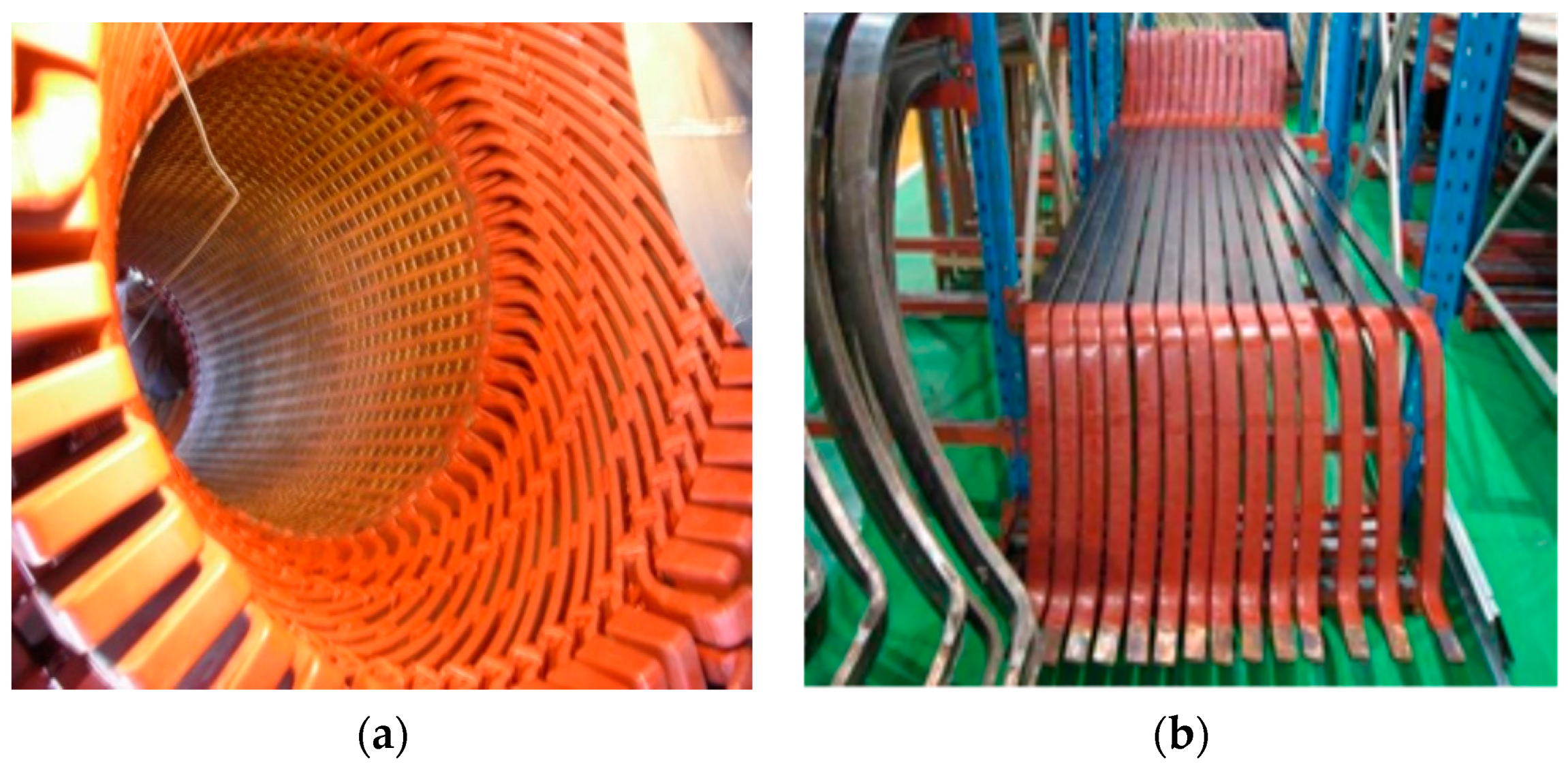
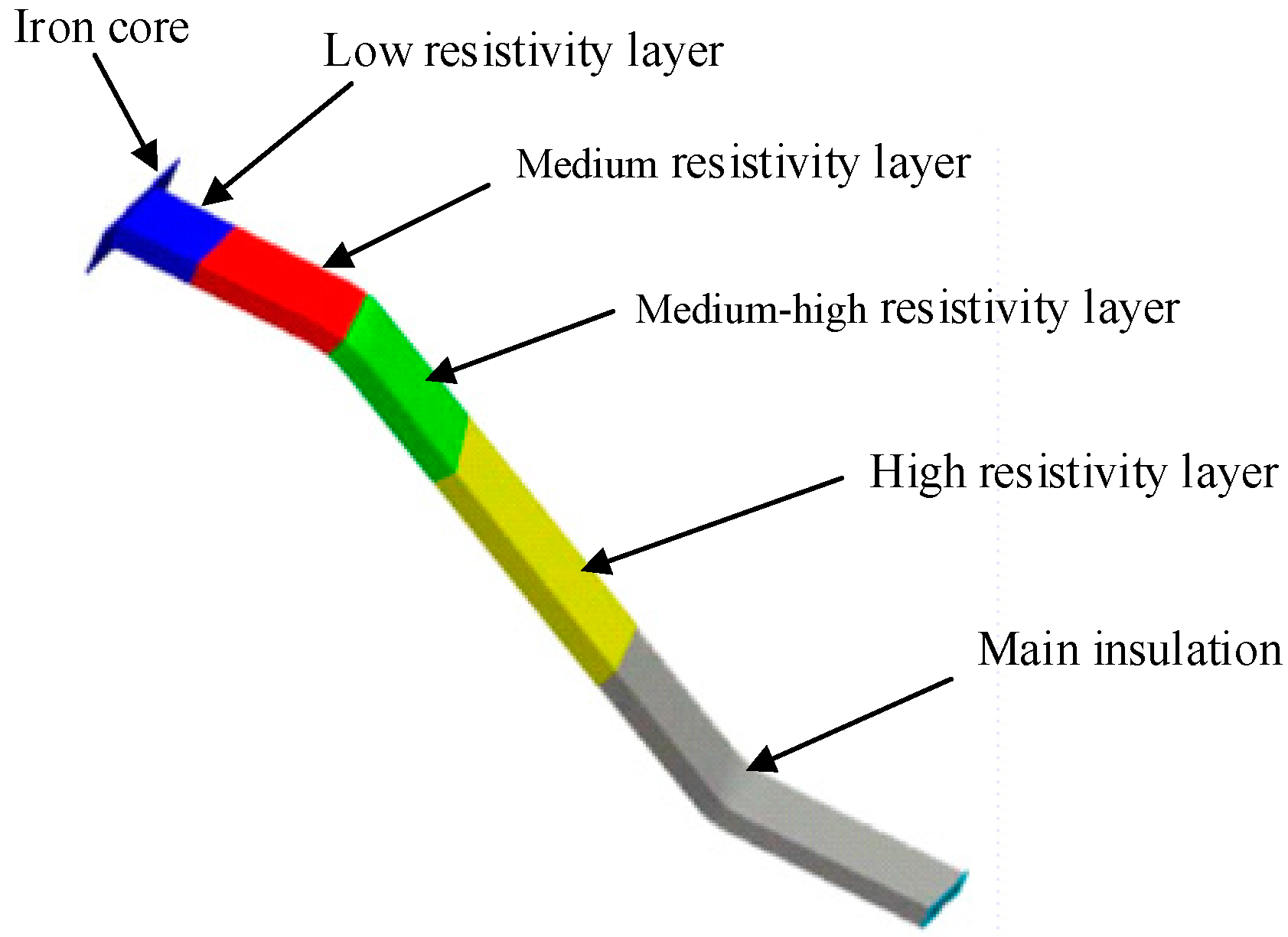

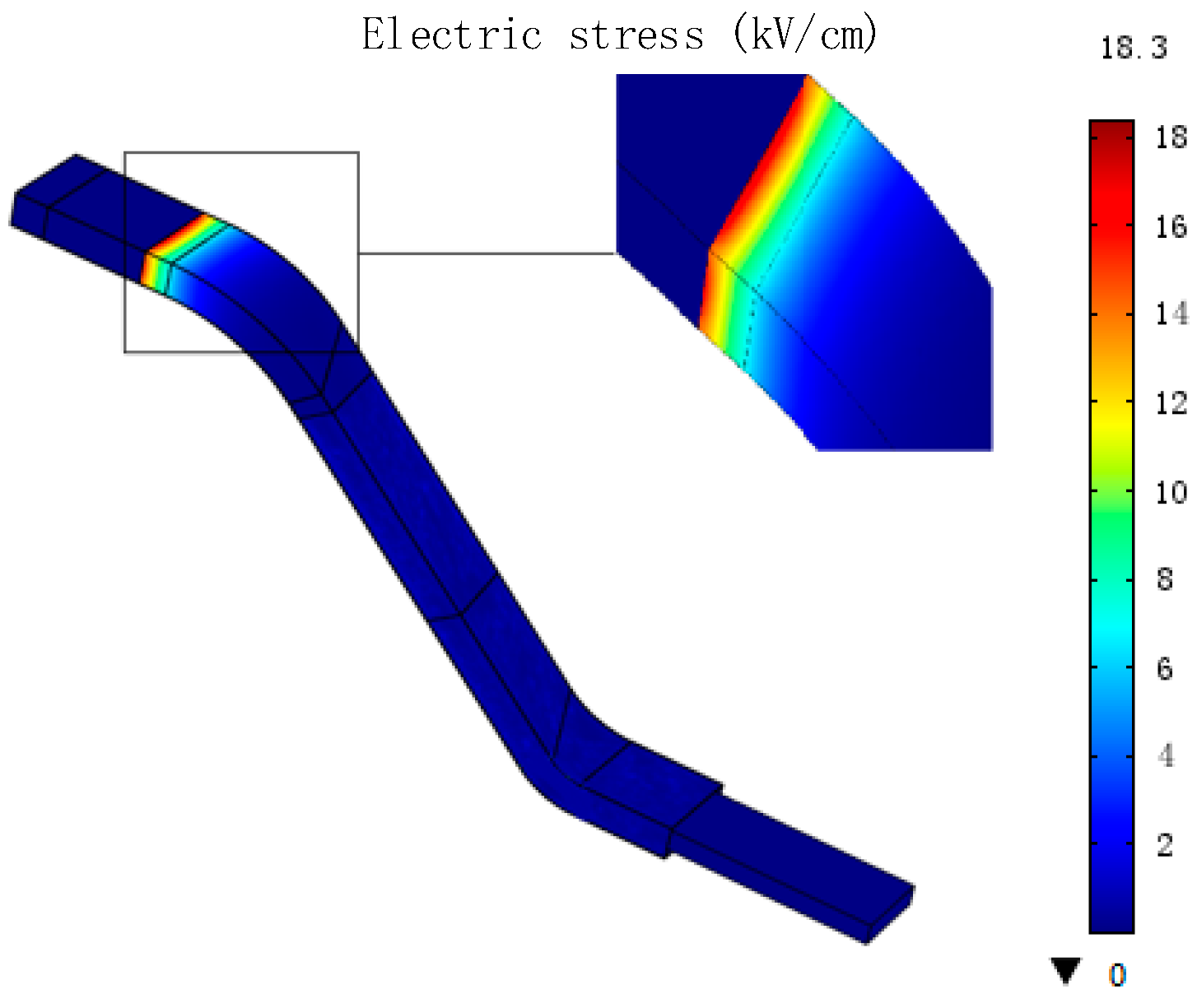

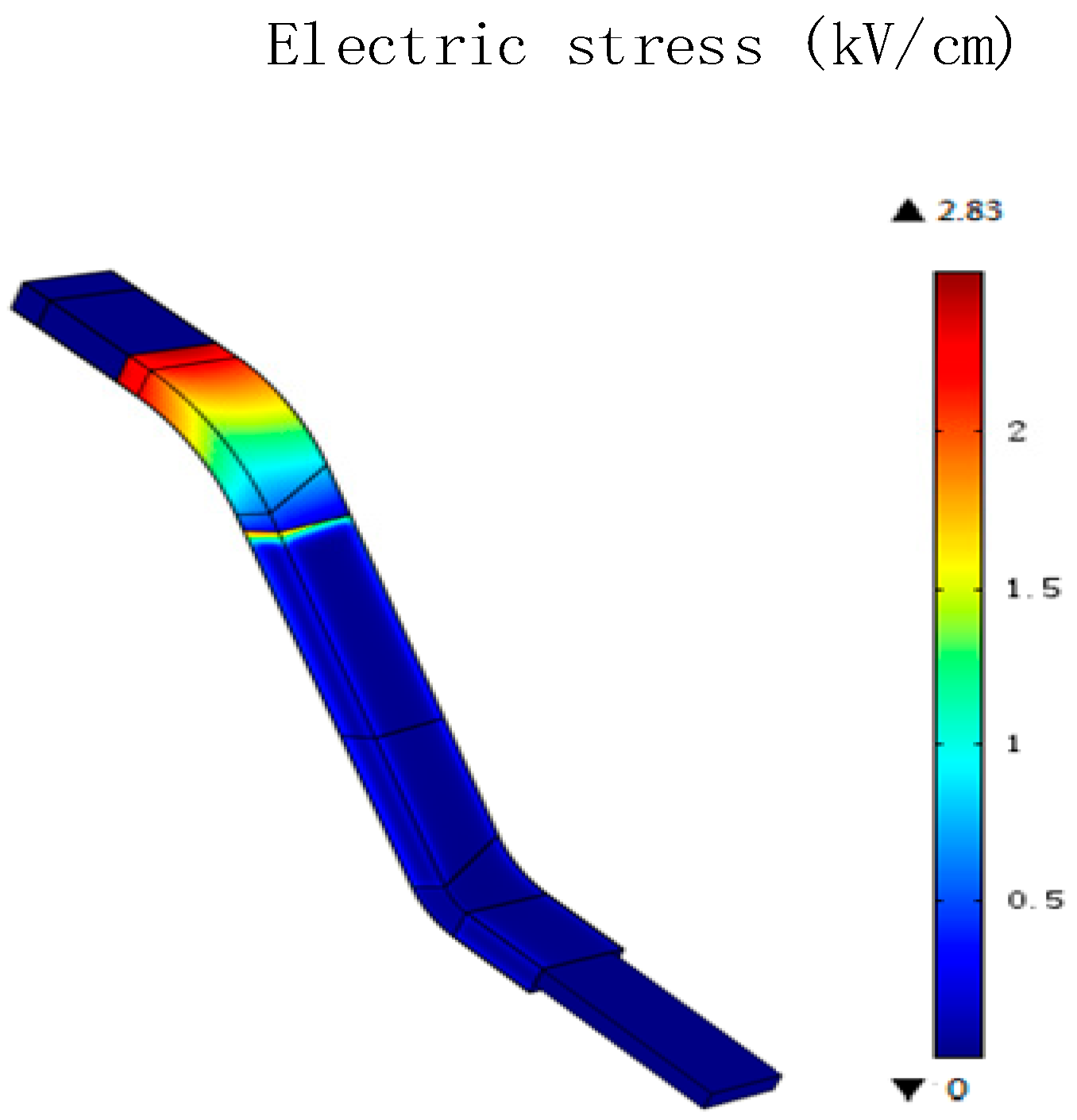

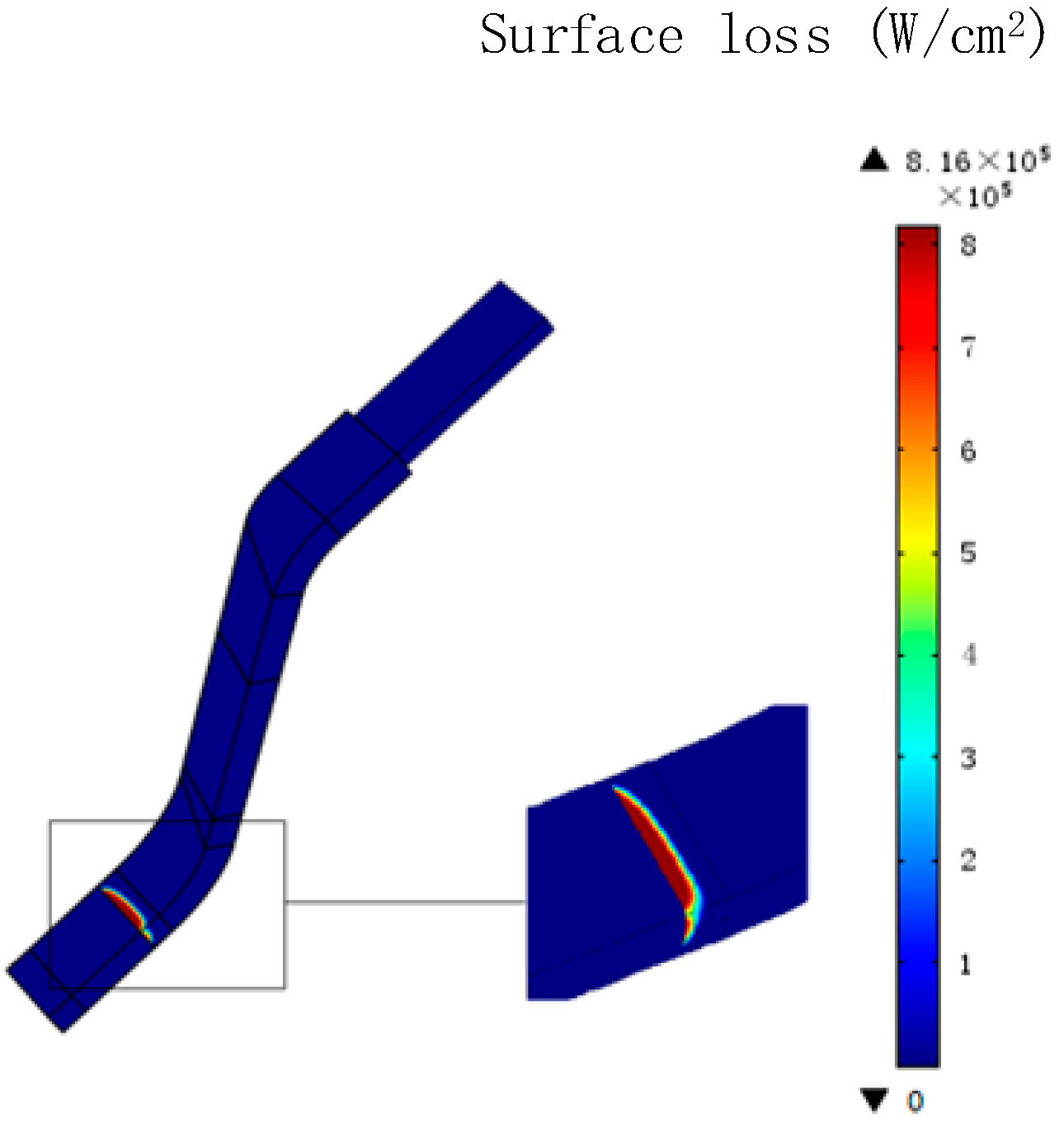

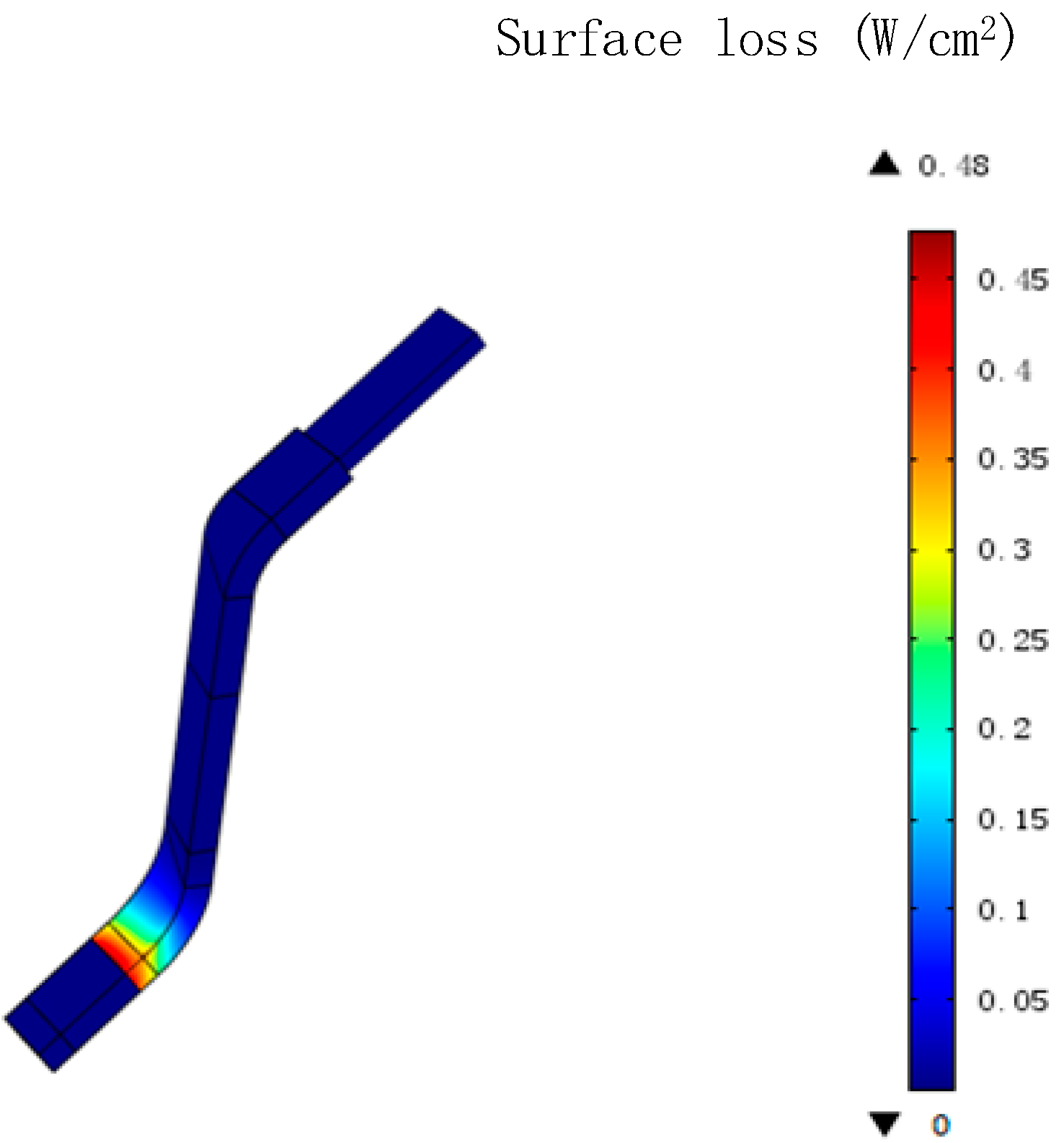
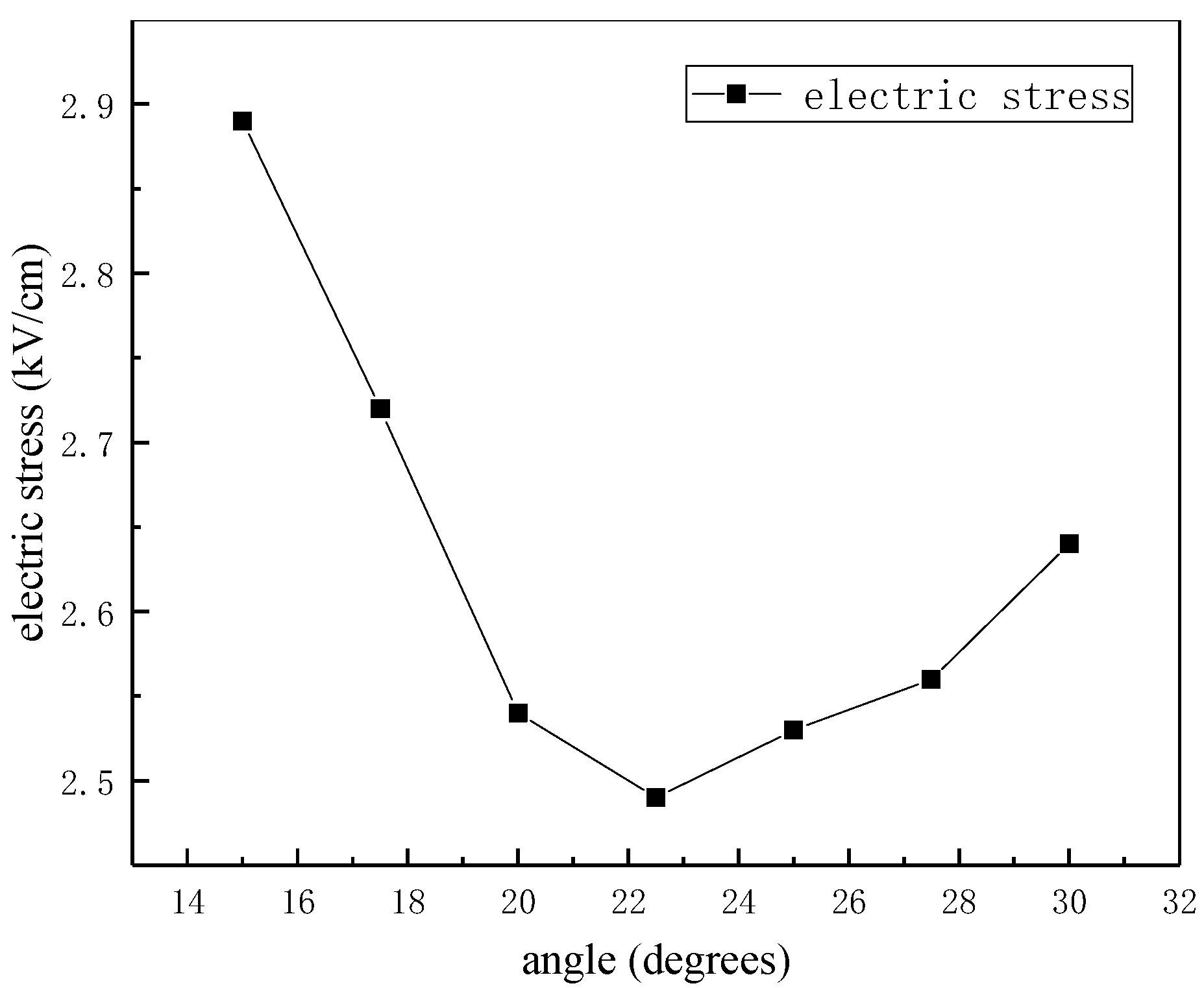
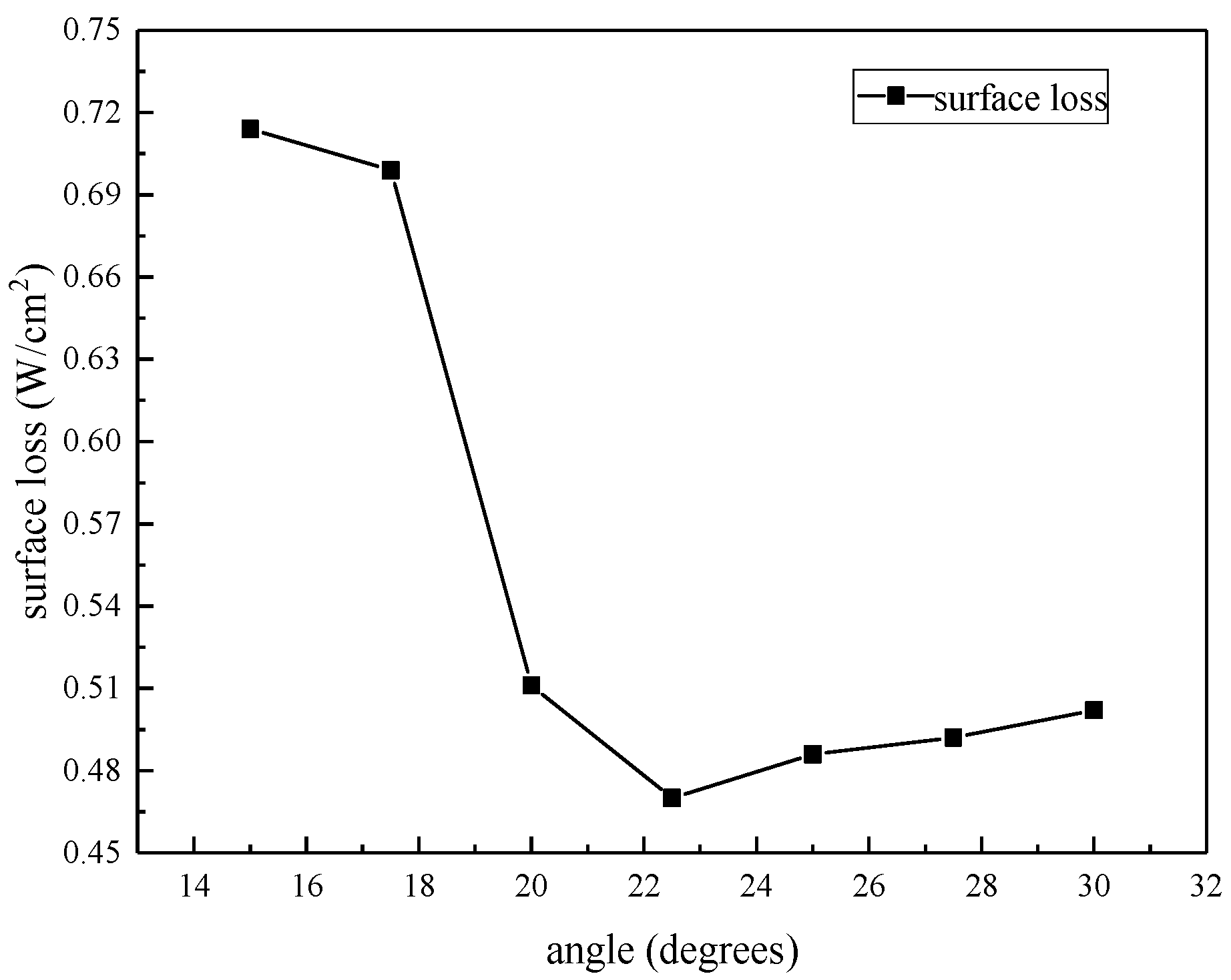
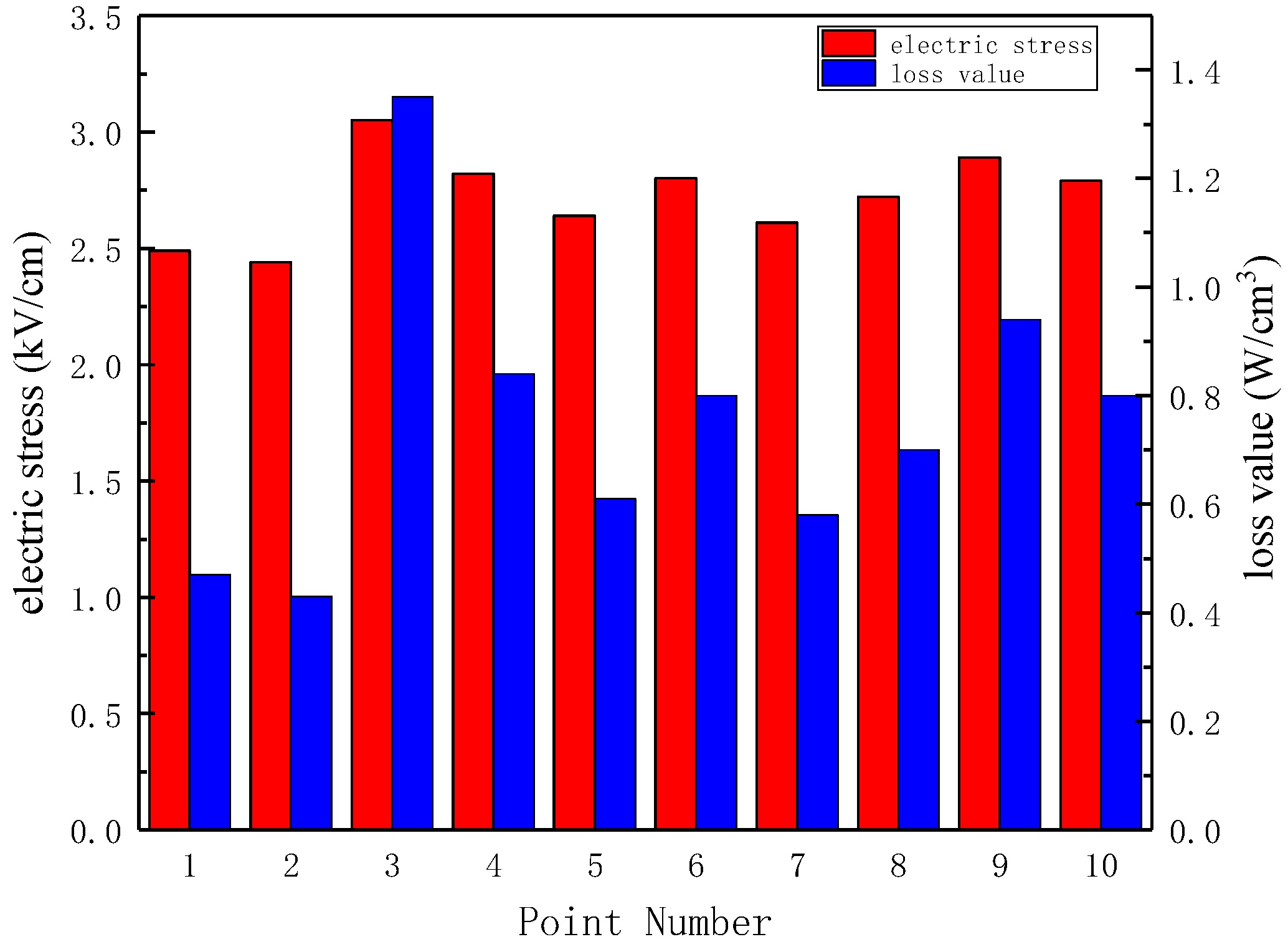
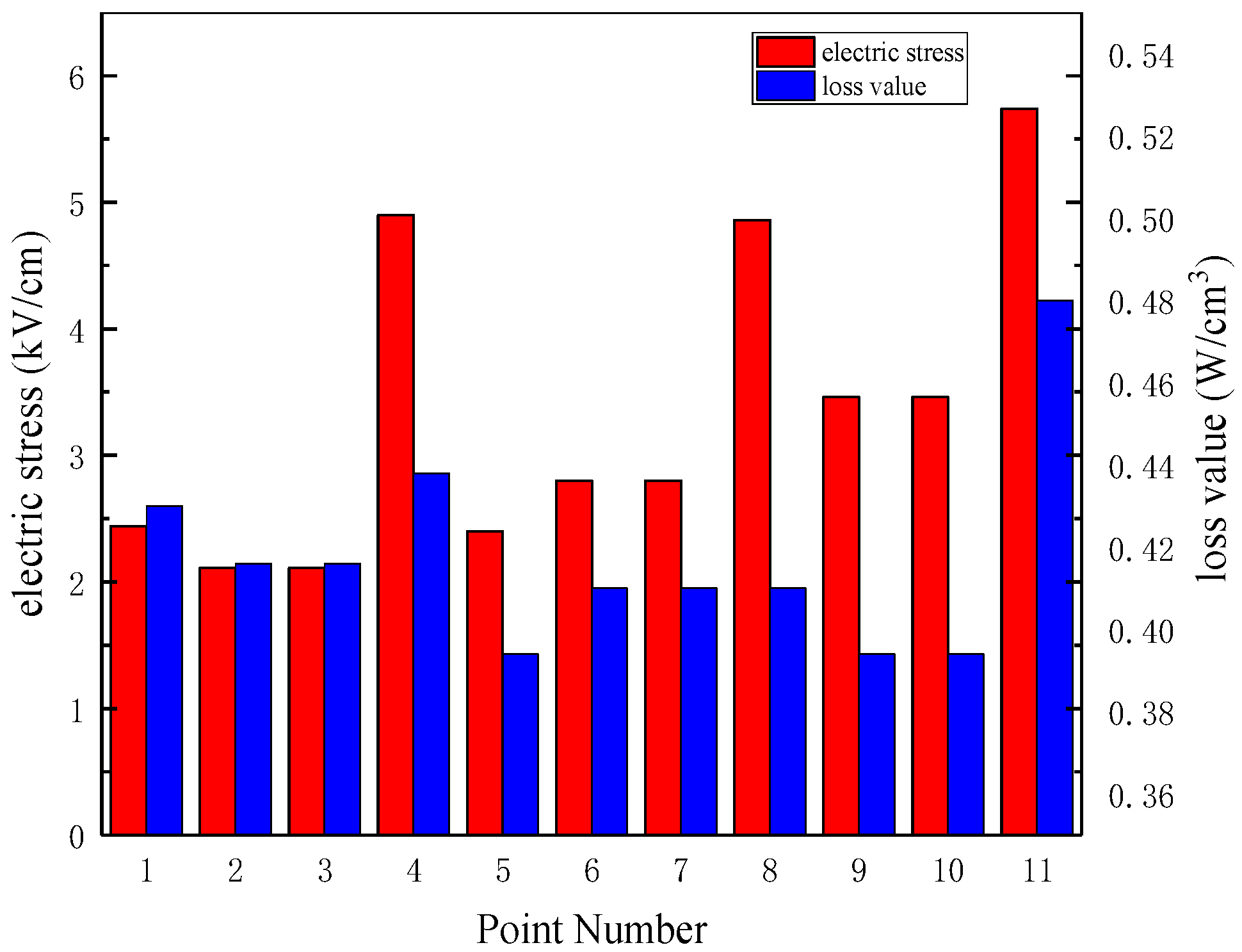
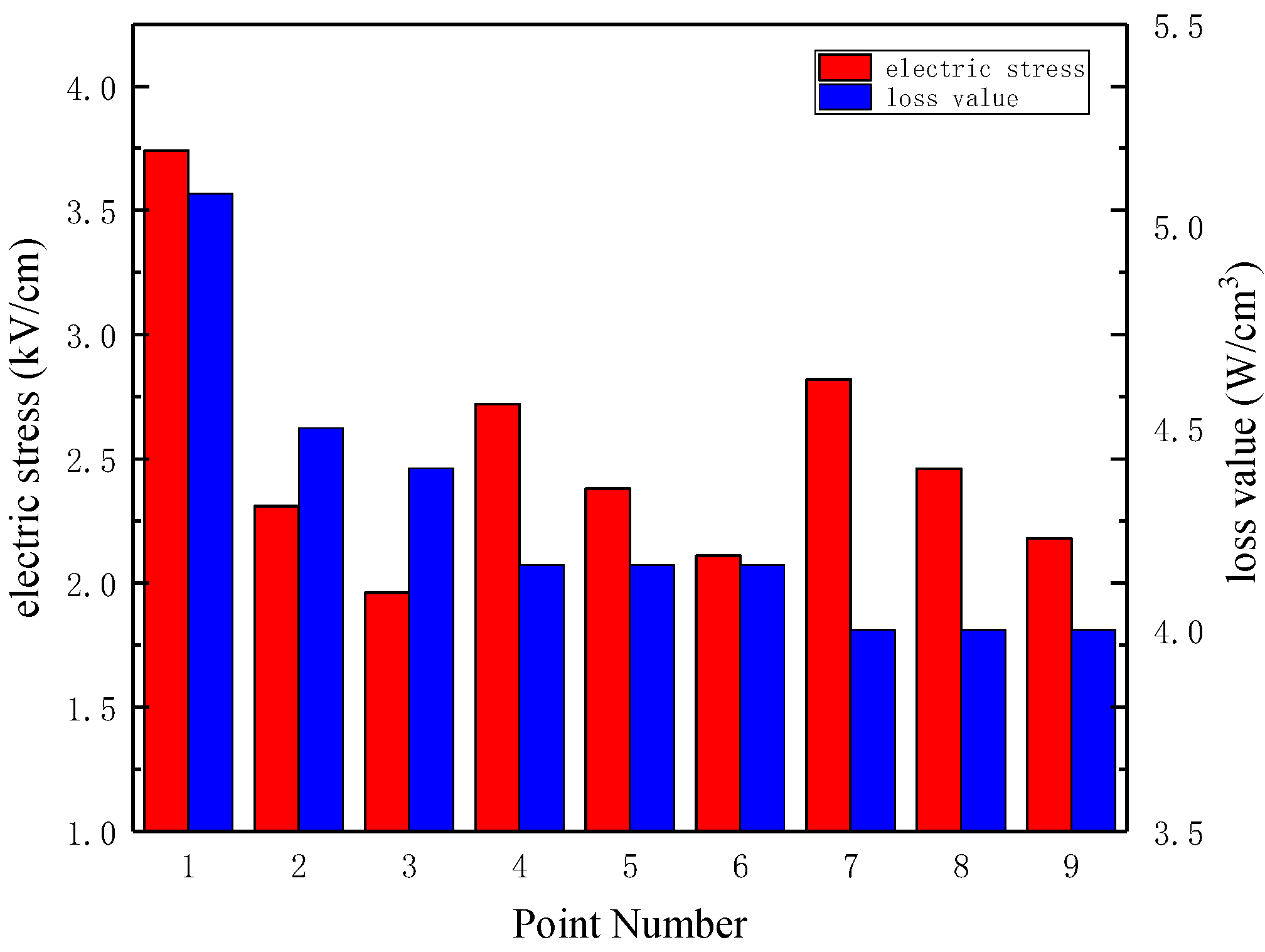
| Point Number | Corona Protection Layer | ||
|---|---|---|---|
| Medium Resistivity Layer (mm) | Medium-High Resistivity Layer (mm) | High Resistivity Layer (mm) | |
| 1 | 170 | 183 | 232 |
| 2 | 170 | 204 | 211 |
| 3 | 170 | 226 | 189 |
| 4 | 170 | 247 | 167 |
| 5 | 170 | 269 | 146 |
| 6 | 192 | 161 | 232 |
| 7 | 213 | 140 | 232 |
| 8 | 235 | 118 | 232 |
| 9 | 256 | 96 | 232 |
| 10 | 278 | 75 | 232 |
| Point Number | Resistivity of the Corona Protection Layer at All Levels | ||
|---|---|---|---|
| Medium Resistivity Layer (Ω·m) | Medium-High Resistivity Layer (Ω·m) | High Resistivity Layer (Ω·m) | |
| 1 | 1 × 106 | 1 × 108 | 1 × 109 |
| 2 | 1 × 106 | 1 × 107 | 1 × 109 |
| 3 | 1 × 106 | 1 × 107 | 1 × 108 |
| 4 | 1 × 106 | 1 × 109 | 1 × 1010 |
| 5 | 1 × 107 | 1 × 108 | 1 × 109 |
| 6 | 1 × 107 | 1 × 109 | 1 × 1010 |
| 7 | 1 × 107 | 1 × 109 | 1 × 1011 |
| 8 | 1 × 107 | 1 × 1010 | 1 × 1011 |
| 9 | 1 × 108 | 1 × 109 | 1 × 1010 |
| 10 | 1 × 108 | 1 × 1010 | 1 × 1011 |
| 11 | 1 × 109 | 1 × 1010 | 1 × 1011 |
| Point Number | Nonlinear Coefficient of the Corona Protection Layer at All Levels | ||
|---|---|---|---|
| Medium Resistivity Layer (cm/kV) | Medium-High Resistivity Layer (cm/kV) | High Resistivity Layer (cm/kV) | |
| 1 | -- | -- | -- |
| 2 | 0.8 | 1.0 | 1.2 |
| 3 | 0.8 | 1.2 | 1.2 |
| 4 | 1.0 | 0.8 | 1.2 |
| 5 | 1.0 | 1.0 | 1.2 |
| 6 | 1.0 | 1.2 | 1.2 |
| 7 | 1.2 | 0.8 | 1.2 |
| 8 | 1.2 | 1.0 | 1.2 |
| 9 | 1.2 | 1.2 | 1.2 |
© 2018 by the authors. Licensee MDPI, Basel, Switzerland. This article is an open access article distributed under the terms and conditions of the Creative Commons Attribution (CC BY) license (http://creativecommons.org/licenses/by/4.0/).
Share and Cite
Hu, H.; Zhang, X.; Liu, Y.; Guo, L.; Gao, J. Optimization of the Electric Field Distribution at the End of the Stator in a Large Generator. Energies 2018, 11, 2510. https://doi.org/10.3390/en11102510
Hu H, Zhang X, Liu Y, Guo L, Gao J. Optimization of the Electric Field Distribution at the End of the Stator in a Large Generator. Energies. 2018; 11(10):2510. https://doi.org/10.3390/en11102510
Chicago/Turabian StyleHu, Haitao, Xiaohong Zhang, Yanli Liu, Lijun Guo, and Junguo Gao. 2018. "Optimization of the Electric Field Distribution at the End of the Stator in a Large Generator" Energies 11, no. 10: 2510. https://doi.org/10.3390/en11102510
APA StyleHu, H., Zhang, X., Liu, Y., Guo, L., & Gao, J. (2018). Optimization of the Electric Field Distribution at the End of the Stator in a Large Generator. Energies, 11(10), 2510. https://doi.org/10.3390/en11102510





